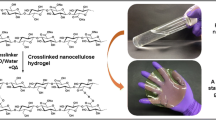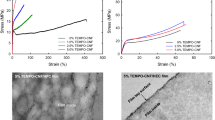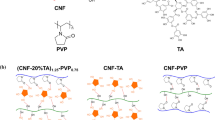Abstract
A surface-carboxylated nanocellulose was prepared from wood cellulose by catalytic oxidation with 2,2,6,6-tetramethylpiperidine-1-oxyl radical (TEMPO). The fibrous TEMPO-oxidized cellulose with sodium carboxylate groups (TOC-Na) was surface-hydrophobized by counterion exchange with tetra-n-butylammonium [TOC-N(n-Bu)4]. This fibrous TOC-N(n-Bu)4 was mechanically disintegrated in water and N,N-dimethylformamide (DMF) to prepare dispersions of TEMPO-oxidized cellulose nanofibrils (TOCNs) with tetra-n-butylammonium counterions, i.e., TOCN-N(n-Bu)4/water and TOCN-N(n-Bu)4/DMF. TOCN-N(n-Bu)4/rubber composite films were prepared by mixing TOCN-N(n-Bu)4 and hydrogenated acrylonitrile–butadiene rubber (H-NBR), used as a polymer matrix, in heterogeneous and homogeneous systems with water and DMF, respectively, followed by casting and drying. The TOCN-N(n-Bu)4/H-NBR composite films prepared in the heterogeneous and homogeneous systems both had a high Young’s modulus of ~ 45 MPa and low coefficients of thermal expansion of ~ 20 ppm/K at a TOCN/H-NBR ratio of 5/100 (w/w). In contrast, the tensile strengths and strain-to-failure values of the composite films prepared using the two systems clearly differed. These different properties are probably caused by differences between the TOCN distributions in the H-NBR matrix and between the H-NBR matrix structures in the two systems. The composite films prepared in the homogeneous system with DMF as the medium are likely to have a more homogeneous distribution of TOCN elements in a homogeneous H-NBR polymer matrix, resulting in a higher tensile strength and work-of-fracture at TOCN/H-NBR = 5/100 (w/w) compared with those of the films prepared in the heterogeneous system with water.
Graphical abstract











Similar content being viewed by others
References
Abraham E, Deepa B, Pothan LA, John M, Narine SS, Thomas S, Anandjiwala R (2013) Physicomechanical properties of nanocomposites based on cellulose nanofibre and natural rubber latex. Cellulose 20:417–427. https://doi.org/10.1007/s10570-012-9830-1
Aimura Y (1997) Fundamental properties and applications of hydrogenated nitrile rubber. Nippon Gomu Kyokaishi 70:681–688. https://doi.org/10.2324/gomu.70.681
Annamalai PK, Dagnon KL, Monemian S, Foster EJ, Rowan SJ, Weder C (2014) Water-responsive mechanically adaptive nanocomposites based on styrene-butadiene rubber and cellulose nanocrystals—processing matters. ACS Appl Mater Interfaces 6:967–976. https://doi.org/10.1021/am404382x
Bendahou A, Kaddami H, Dufresne A (2010) Investigation on the effect of cellulosic nanoparticles’ morphology on the properties of natural rubber based nanocomposites. Eur Polym J 46:609–620. https://doi.org/10.1016/j.eurpolymj.2009.12.025
Bras J, Hassan ML, Bruzesse C, Hassan EA, El-Wakil NA, Dufresne A (2010) Mechanical, barrier, and biodegradability properties of bagasse cellulose whiskers reinforced natural rubber nanocomposites. Ind Crops Prod 32:627–633. https://doi.org/10.1016/j.indcrop.2010.07.018
Brünig M (1998) Numerical analysis of modeling of large deformation and necking behavior of tensile specimens. Finite Elem Anal Des 28:303–319. https://doi.org/10.1016/S0168-874X(97)00042-5
Bucknall CB, Smith RR (1965) Stress-whitening in high-impact polystyrenes. Polymer 6:437–446. https://doi.org/10.1016/0032-3861(65)90028-5
De SK, White JR (1996) Short fibre-polymer composites. Woodhead Publishing, Cambridge. ISBN 1-85573-220-3
Deng F, Ito M, Noguchi T, Wang L, Ueki H, Niihara KI, Kim YA, Endo M, Zeng QS (2011) Elucidation of the reinforcing mechanism in carbon nanotube/rubber nanocomposites. ACS Nano 5:3858–3866. https://doi.org/10.1021/nn200201u
Endo M, Noguchi T, Ito M, Takeuchi K, Hayashi T, Kim YA, Wanibuchi T, Jinnai H, Terrones M, Dresselhaus MS (2008) Extreme-performance rubber nanocomposites for probing and excavating deep oil resources using multi-walled carbon nanotubes. Adv Funct Mater 18:3403–3409. https://doi.org/10.1002/adfm.200801136
Fujisawa S, Ikeuchi T, Takeuchi M, Saito T, Isogai A (2012a) Superior reinforcement effect of TEMPO-oxidized cellulose nanofibrils in polystyrene matrix: optical, thermal, and mechanical studies. Biomacromolecules 13:2188–2194. https://doi.org/10.1021/bm300609c
Fujisawa S, Saito T, Kimura S, Iwata T, Isogai A (2012b) Surface engineering of ultrafine cellulose nanofibrils toward polymer nanocomposite materials. Biomacromolecules 14:1541–1546. https://doi.org/10.1021/bm400178m
Fujisawa S, Saito T, Kimura S, Iwata T, Isogai A (2014) Comparison of mechanical reinforcement effects of surface-modified cellulose nanofibrils and carbon nanotubes in PLLA composites. Compos Sci Technol 90:96–101. https://doi.org/10.1016/j.compscitech.2013.10.021
Fukui S, Ito T, Saito T, Noguchi T, Isogai A (2018) Counterion design of TEMPO-nanocellulose used as filler to improve properties of hydrogenated acrylonitrile-butadiene matrix. Compos Sci Technol 167:339–345. https://doi.org/10.1016/j.compscitech.2018.08.023
Fukuzumi H, Saito T, Iwata T, Kumamoto Y, Isogai A (2009) Transparent and high gas barrier films of cellulose nanofibers prepared by TEMPO-mediated oxidation. Biomacromolecules 10:162–165. https://doi.org/10.1021/bm801065u
Gatos KG, Százdi L, Pukánszky B, Karger-Kocsis J (2005) Controlling the deintercalation in hydrogenated nitrile rubber (HNBR)/organo-montmorillonite nanocomposite by curing with peroxide. Macromol Rapid Commun 26:915–919. https://doi.org/10.1002/marc.200500084
Habibi Y, Lucian L, Rojas OJ (2010) Cellulose nanocrystals: chemistry, self-assembly, and applications. Chem Rev 110:3479–3500. https://doi.org/10.1021/cr900339w
Haraguchi K, Ebato M, Takehisa T (2006) Polymer-clay nanocomposites exhibiting abnormal necking phenomena accompanied by extremely large reversible elongations and excellent transparency. Adv Mater 18:2250–2254. https://doi.org/10.1002/adma.200600143
Hshim AS, Azahari B, Ikeda Y, Kohjiya S (1998) The effect of bis(3-triethoxysilylpropyl)tetrasulfide on silica reinforcement of styrene-butadiene rubber. Rubber Chem Technol 71:289–299. https://doi.org/10.5254/1.3538485
Isogai A (2013) Wood nanocelluloses: fundamentals and applications as new bio-based nanomaterials. J Wood Sci 59:449–459. https://doi.org/10.1007/s10086-013-1365-z
Isogai A, Saito T, Fukuzumi H (2011) TEMPO-oxidized cellulose nanofibers. Nanoscale 3:71–85. https://doi.org/10.1039/c0nr00583e
Kader MA, Kim K, Lee YS, Nah C (2006) Preparation and properties of nitrile rubber/montmorillonite nanocomposites via latex blending. J Mater Sci 41:7341–7352. https://doi.org/10.1007/s10853-006-0792-2
Karasek L, Sumita M (1996) Characterization of dispersion state of filler and polymer-filler interactions in rubber-carbon black composites. J Mater Sci 31:281–289. https://doi.org/10.1007/BF01139141
Klemm D, Kramer F, Moritz S, Lindström T, Ankerfors M, Gray D, Dorris A (2011) Nanocelluloses: a bew family of nature-based materials. Angew Chem 50:5438–5466. https://doi.org/10.1002/anie.201001273
Moon RJ, Martini A, Nairn J, Simonsen J, Yungblood J (2011) Cellulose nanomaterials review: structure, properties and nanocomposites. Chem Soc Rev 40:3941–3994. https://doi.org/10.1039/C0CS00108B
Nair KG, Dufresne A (2003) Crab shell chitin whisker reinforced natural rubber nanocomposites. 2. Mechanical behavior. Biomacromolecules 4:666–674. https://doi.org/10.1021/bm0201284
Parambath Kanoth B, Claudino M, Johansson M, Berglund LA, Zhou Q (2015) Biocomposites from ntural rubber: synergistic effects of functionalized cellulose nanocrystals as both reinforcing and cross-linking agents via free-radical thiol–ene chemistry. ACS Appl Mater Interfaces 7:16303–16310. https://doi.org/10.1021/acsami.5b03115
Saito T, Nishiyama Y, Putaux JL, Vignon M, Isogai A (2006) Homogeneous suspensions of individualized microfibrils from TEMPO-catalyzed oxidation of native cellulose. Biomacromolecules 7:1687–1691. https://doi.org/10.1021/bm060154s
Saito T, Kimura S, Nishiyama Y, Isogai A (2007) Cellulose nanofibers prepared by TEMPO-mediated oxidation of native cellulose. Biomacromolecules 8:2485–2491. https://doi.org/10.1021/bm0703970
Shimizu M, Saito T, Isogai A (2014a) Bulky quaternary alkylammonium counterions enhance the nanodispersibility of 2,2,6,6-tetramethylpiperidine-1-oxyl-oxidized cellulose in diverse solvents. Biomacromolecules 15:1904–1909. https://doi.org/10.1021/bm500384d
Shimizu M, Saito T, Fukuzumi H, Isogai A (2014b) Hydrophobic, ductile, and transparent nanocellulose films with quaternary alkylammonium carboxylates on nanofibril surfaces. Biomacromolecules 15:4320–4325. https://doi.org/10.1021/bm501329v
Shimizu M, Saito T, Isogai A (2016) Water-resistant and high oxygen-barrier nanocellulose films with interfibrillar cross-linkages formed through multivalent metal ions. J Membr Sci 500:1–7. https://doi.org/10.1021/bm2017542
Shinoda R, Saito T, Okita Y, Isogai A (2012) Relationship between length and degree of polymerization of TEMPO-oxidized cellulose nanofibrils. Biomacromolecules 13:842–849. https://doi.org/10.1021/bm2017542
Soeta H, Fujisawa S, Saito T, Berglund L, Isogai A (2015) Low-birefringent and highly tough nanocellulose-reinforced cellulose triacetate. ACS Appl Mater Interfaces 7:11041–11046. https://doi.org/10.1021/acsami.5b02863
Tervoort TA, Govaert LE (2000) Strain-hardening behavior of polycarbonate in the glassy state. J Rheol 44:1263–1277. https://doi.org/10.1122/1.1319175
Varghese S, Karger-Kocsis J (2003) Natural rubber-based nanocomposites by latex compounding with layered silicates. Polymer 44:4921–4927. https://doi.org/10.1016/S0032-3861(03)00480-4
Wang MJ (1998) Effect of polymer-filler and filler-filler interactions on dynamic properties of filled vulcanizates. Rubber Chem Technol 71:520–589. https://doi.org/10.5254/1.3538492
Wu PD, van der Giessen E (1995) On neck propagation in amorphous glassy polymers under plane strain tension. Int J Plast 11:211–235. https://doi.org/10.1016/0749-6419(94)00043-3
Acknowledgments
This research was supported by Core Research for Evolutional Science and Technology (CREST, Grant Number JPMJCR13B2) of the Japan Science and Technology Agency (JST). We thank Helen McPherson, Ph.D., from Edanz Group (www.edanzediting.com/ac) for editing a draft of this manuscript.
Author information
Authors and Affiliations
Corresponding author
Rights and permissions
About this article
Cite this article
Fukui, S., Ito, T., Saito, T. et al. Surface-hydrophobized TEMPO-nanocellulose/rubber composite films prepared in heterogeneous and homogeneous systems. Cellulose 26, 463–473 (2019). https://doi.org/10.1007/s10570-018-2107-6
Received:
Accepted:
Published:
Issue Date:
DOI: https://doi.org/10.1007/s10570-018-2107-6




